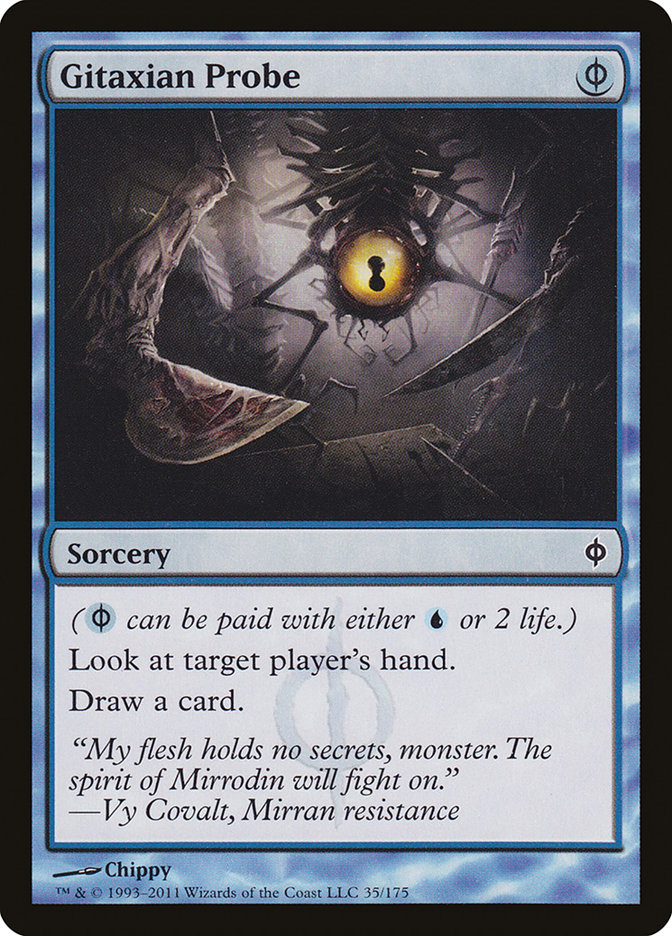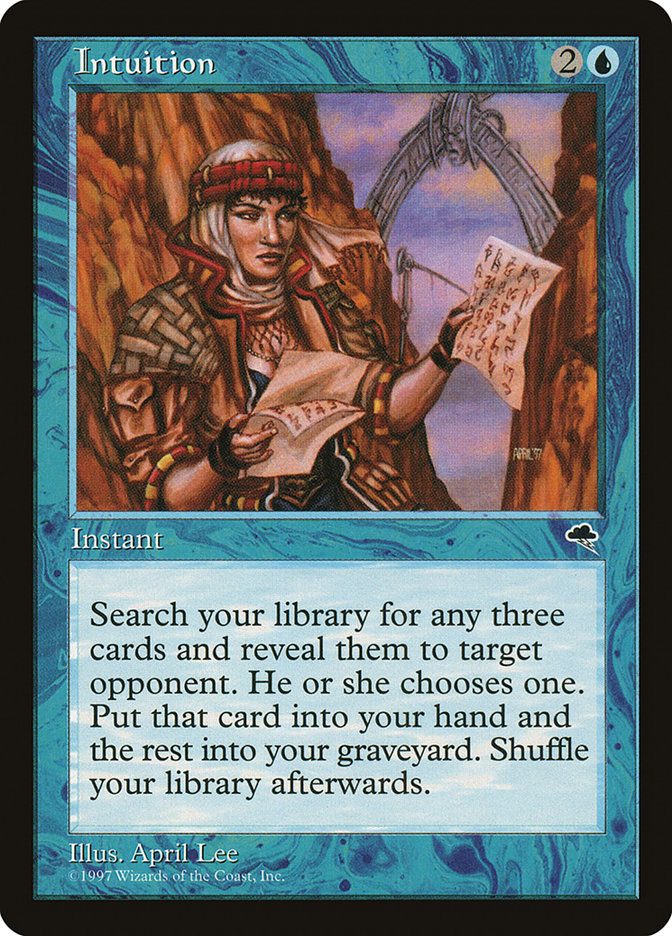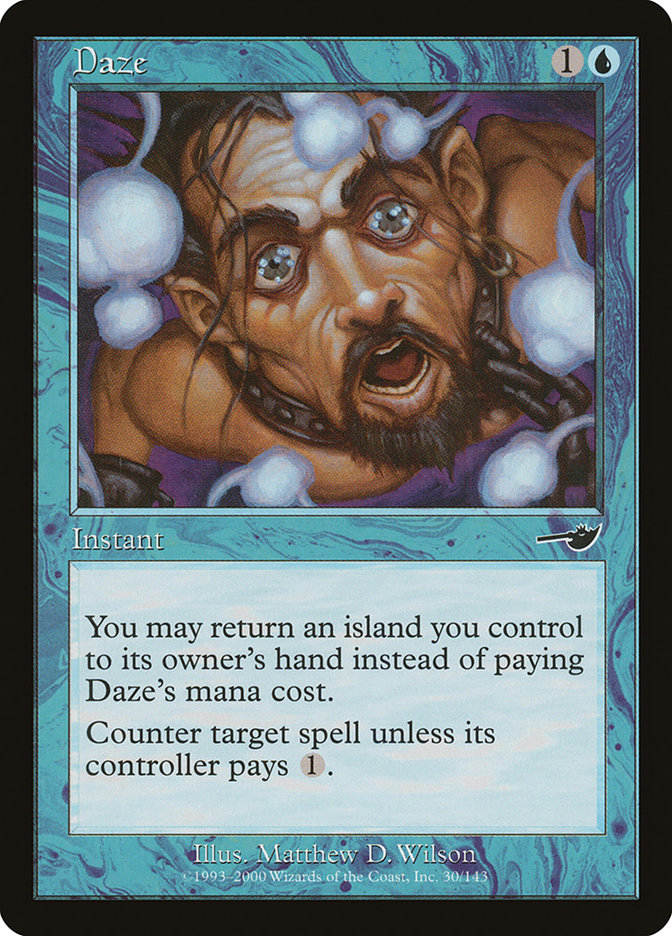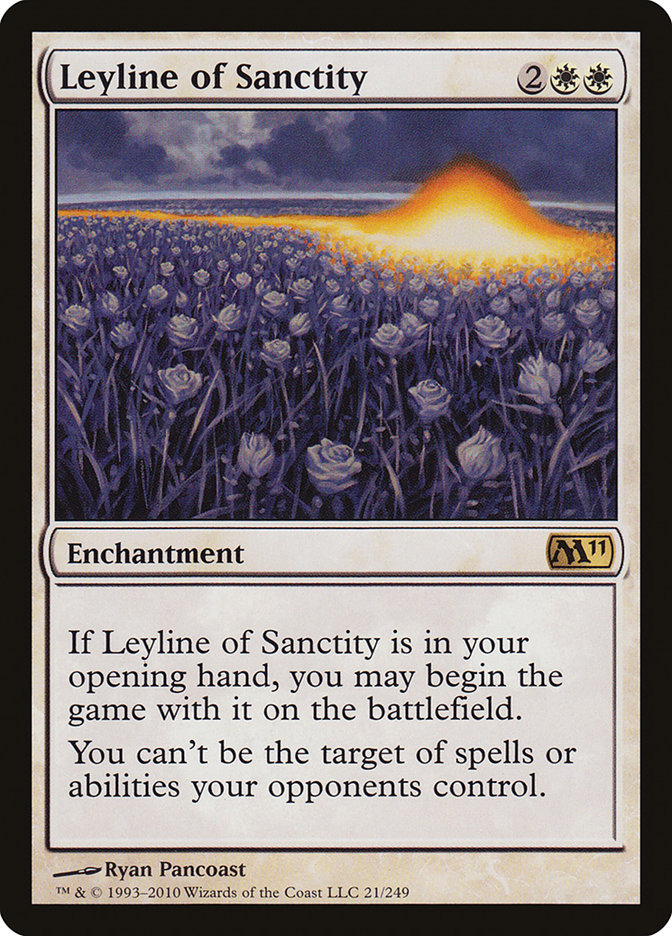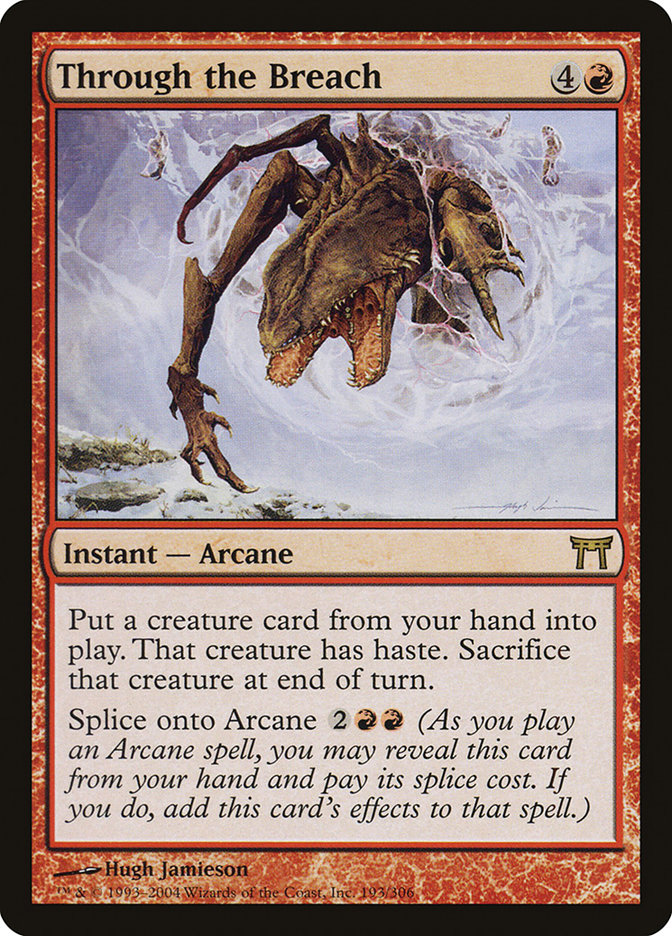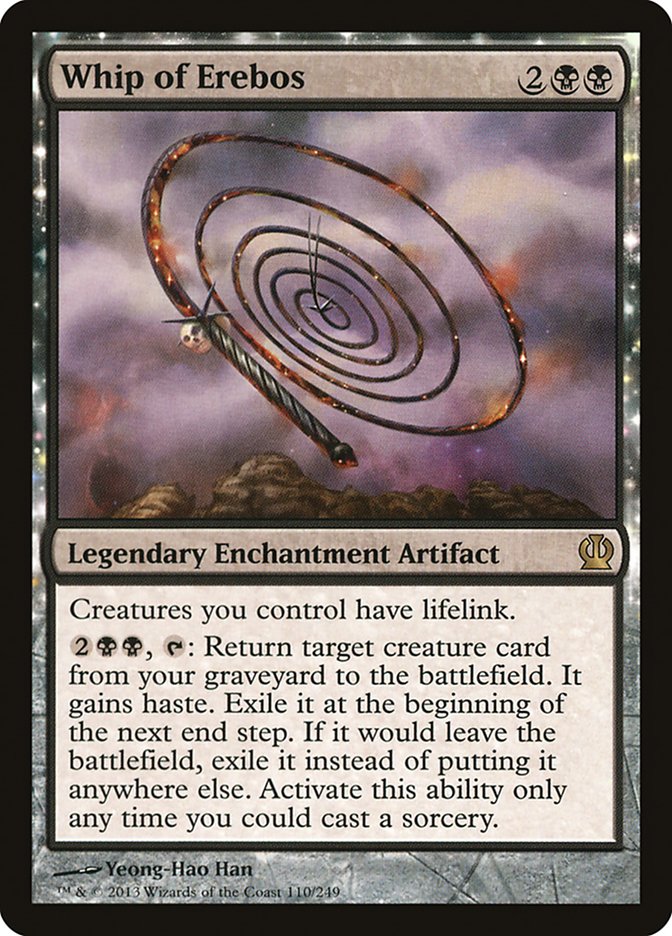"Nothin’ beat surprise—’cept rock." — Flavor text, Sneak Attack
"Nothin’ beat rock—’cept paper . . . And actually, you know what? I’m not sure I buy it. I think this ‘paper covers rock’ assumption is a little sketchy. I need supporting evidence. I need scientific proof. Because frankly, I find a little hard to swallow that people can’t see the enormous rock under that tiny, flimsy piece of paper. Really? You can’t see that giant, powerful rock bulging out from underneath? You don’t think that this massive rock is going to maybe break through the sheet of paper? I feel like you’re going to go to grab that paper and hurt yourself on the rock underneath. **** rock. I hate rock. Rock sucks." — Diary of a Scissors Lizard
Combo. One simple five-letter word has struck fear in the hearts of Magic players around the world. Any time my opponent led with Island, Ponder, a sinking feeling would well up in my stomach.
"I hope they don’t have it. Please shuffle that Ponder. What if they have it? What if I lose this game and there’s nothing I can do? Please shuffle that Ponder. I have all these dead cards in hand. Shuffle. That. Ponder. PLEASE! CAN I GET A SHUFFLE ON THAT PONDER ONE TIME?!"
They keep the top three cards with Ponder. They look up with a smirk on their face and pass the turn to me. I go through the motions, but I basically know I’m dead. The next turn, they cast Show and Tell, and my pet goldfish and bag of string can’t quite match up to their flying lifelink Demon. Oops. Guess I lose. Again.
We tend to always fear that which we don’t know. I am not a combo player. I have never been a combo player. I have always faced combo from the other side of the board. I have always lived in constant fear of combo. Until recently, that is.
I decided it was time I faced my fears. I wanted combo to be a known entity for me. Instead of losing to it all the time, I wanted to play it. It would serve to better myself as a player and teach me both how to win with those decks and win playing against those decks.
I figured it was time I stopped being the one who got knocked out. Instead, I wanted to be the one who knocks.
I’ve played a combo deck in the last three SCG Legacy Opens in a row now. I was surprised by what I learned. Most surprising to myself was the realization that I am actually not bad at playing combo. Well, either that or these decks are so unbelievably good that even a newbie like me can do well with them. It might be a bit of both. Even more surprising was the realization that I liked playing combo. It felt like a puzzle. I knew what cards I needed to beat. Could I piece together the right lines of play to beat them? Solving the puzzle was not only fun but rewarding.
Step one was Ad Nauseam Tendrils. After losing more win-and-ins in just two events with that deck than I can count,* I was satisfied. The deck is good, very good even, and I am sure I will return to playing Storm at some point. But there was more out there.
Step two was Sneak and Show. I felt that this is the best Show and Tell deck in the format. Omni-tell is a three-card combo. You need some combination of Show and Tell, Dream Halls, Omniscience, and Enter the Infinite, but you always needed three pieces. The exception is a five-mana Dream Halls and Enter the Infinite, but even then you need another blue card to pitch to Enter the Infinite and are paying five mana. The combo just felt slow and easily disruptable. I wasn’t on board.
Sneak and Show is faster and requires less to go off. You typically don’t win the turn you play the combo, but most opponents don’t have a good answer to at least one, if not more, of the many ways you can pressure them: Emrakul, Griselbrand, or just good old Sneak Attack. Good ol’ rock. Nothing beats rock.
I decided that I was going to play Sneak and Show at the StarCityGames.com Legacy Open in Philadelphia fairly early in the week. To figure out my list, I employed the rigorous testing process of looking at every Sneak and Show list that put up results in the past three months and just going with the card choices I thought would probably be best based on no actual playtesting. I ended up settling on this list:
Creatures (8)
Lands (15)
Spells (37)

I’d like to talk about some of the card choices I made as well as some I didn’t.
Show Me What You’re Made Of
Gitaxian Probe
I feel like this is the biggest difference between my list and most of the ones I saw. After playing with Gitaxian Probe in Storm, I was very impressed with the card. There is a running fallacy that you shouldn’t need to see your opponent’s hand because you should be able to figure it out based on how the game has progressed.
Screw that noise! Yeah, I might be able to piece together some information about my opponent’s hand over the course of the game, but I actually have discovered a more robust plan. It’s called looking directly at your opponent’s hand and writing down the contents. This may come as a shock, but it has proven to be a slightly more effective tool at piecing together my opponent’s hand than "just trying to figure it out." Just ever so slightly.
Keep in mind that Sneak and Show plays a card that lets our opponent put a card directly from their hand into play in Legacy, the format where nearly every powerful card from Magic’s history is legal. If your opponent has six cards in hand on turn 2 and you’re about to cast Show and Tell, how the hell are you supposed to be able to figure out if they have an Oblivion Ring, Humility, Ensnaring Bridge, or some other card you can’t ever beat?
Answer: you’re not.
Those six cards could be literally anything. They could even be a Pirate Ship. It doesn’t matter how good you are; there is no way you could figure out what they have in their hand this early in the game. There were a large number of situations where Gitaxian Probe let me know that the coast was clear or that I should probably hold off on casting that Show and Tell unless I particularly felt like losing the game.
It’s hard to figure out exactly how many games I won because of the information from Gitaxian Probe, but I can tell you for sure it was at least two because that’s how many games I won the turn I cast a Gitaxian Probe to tell me the coast was clear when I was otherwise gun-shy to pull the trigger against my opponent’s full grip.
It’s also a free cantrip. Gitaxian Probe combos well with cards like Ponder and Brainstorm. Typically you want to cast the Probe before you cast those other cantrips so that you know what you’re looking for to beat your opponent’s hand and to give you another card worth of information. However, you also have the option of casting a Ponder first and using the Gitaxian Probe to grab another card from your Ponder before you shuffle away the third card with a fetch land.
Intuition
I played just one copy of this card, while some lists play two or even more. Let me be clear about one thing; Intuition is a great card. AJ Sacher claimed it is Demonic Tutor, and that’s essentially true. This deck is full of four-ofs, which means you can almost always just search up three copies of the same card and ensure you get to draw it. If that card is Emrakul, you even get to shuffle your graveyard into your library when the other two Emrakuls hit your yard, which can often be a benefit (you get your Intuition and a bunch of your cantrips back in your library, which now has fewer lands to filter through). You can also use those shuffles to throw away bad cards with Brainstorm.
Why then would I only play one copy? Well, for one it costs three mana. If you don’t have an Ancient Tomb or a City of Traitors, then you are looking at a turn 3 Intuition, which isn’t particularly exciting. Secondly, this deck is a two-card combo deck with eight copies of both of its combo pieces. You have Sneak Attack and Show and Tell to go alongside Emrakul and Griselbrand. Most of the time Ponder and Brainstorm are going to be enough to dig you into the combo.
Daze
Ahh yes, Daze. Daze has been a common nemesis card of mine for some time. What I mean by that is every time I play a deck with Daze in it, I wish I hadn’t. I actually hate playing with this card more than any other card in Legacy, and I actively try to avoid it as much as possible.
Why? Mostly because the card sucks. It’s good when you’re on the play and you’ve developed your board with threats before your opponent can do the same. Then you can counter their threats for free as you deploy more. That sounds awesome, and there’s a reason the card sees play in tempo-oriented decks like Merfolk and Delver variants.
It’s pretty bad every other time.
I just don’t think it’s the right fit for Sneak and Show. It may be good if you have a turn 2 Show and Tell on the play, but what about the game where you’re on the draw with no Ancient Tomb or Lotus Petal and have these Dazes in your hand? You can’t really afford to cast them or you will put yourself back another turn from casting Show and Tell. What about the game where you can’t reliably cast Show and Tell and have to rely on Sneak Attack. Four mana is a long way to go when you’re using Daze to set yourself back.
I’d rather stick with old, reliable Spell Pierce. Spell Pierce was awesome for me. Let’s just say there was a hole in my opponents’ plans of casting Hymn to Tourach and Counterbalance and a number of other early hateful cards. Pierce was also exceptional in combo mirrors, mostly just as a way to harass their cantrips early on and keep them from sculpting the perfect hand.
Blood Moon
I think one of the incentives of playing this deck is that you get access to an awesome hate card like Blood Moon out of the sideboard. The format seems to be adapting to Blood Moon in that a lot of people are abandoning decks like Esper Deathblade that are just cold to it. Still, there are plenty of people playing decks with no basics, and a resolved Blood Moon is going to just beat decks like Jund, Esper Deathblade, Shardless BUG, and RUG Delver by itself.
I only had one match against a deck that was vulnerable to Blood Moon in Philly, when I played against Jund in round 3. I cast Blood Moon on turn 2 in game 2. Deathrite Shaman let him cast another spell, but that was the last spell he cast that game. He had two Dark Confidants in play yet was locked out of the game. That’s the power of Blood Moon.
I wanted to play four Blood Moons, but David McDarby, who has had a lot of success with Sneak and Show in the past, convinced me that playing three was the right number. The card has diminishing returns, and it’s not your primary game plan. I felt that was a reasonable argument, and I would probably stick with three copies again.
Leyline of Sanctity
Four copies of Leyline of Sanctity has basically become commonplace in the sideboard of Sneak and Show. I felt that Leyline is mainly there as a deterrent to discard. Open on a Leyline and your Jund opponent’s hand of Duress, Thoughtseize, and Hymn to Tourach is now completely dead. I avoided playing the card for a few reasons.
First of all, you now have four cards in your deck that do literally nothing. If you don’t open on a Leyline, then every time you draw one it’s a completely dead card. I’ve won a lot of games against combo decks that led with Leyline to shut down my discard and then just died to my creatures because their deck functioned so much worse and they couldn’t piece together what they needed fast enough.
Secondly, Leyline is mainly good against decks that Blood Moon is also good against. Having both Blood Moon and Leyline is overkill in those matches. What cards are you cutting? You run a real risk of having too many "hate" cards and not enough cards to actually win the game. While you durdle around with Leylines and Blood Moons, that turn 2 Tarmogoyf just ends up killing you even if you lock them out from casting spells afterward.
The final point is that I hate adding variance to a deck that already has enough of it. One of the major drawbacks to Sneak and Show is that sometimes you just sit there and do absolutely nothing. Leyline certainly doesn’t help with that.
Through the Breach
Through the Breach ended up being one of the best-performing sideboard cards for me. There are a number of matchups where you have to side out Show and Tell because your opponent can put in as scary or scarier things off of it than what you can. If your opponent is playing Emrakuls, Griselbrands, Omnisciences, or other massive cards like that, then you can’t expect to ever cast Show and Tell profitably. Replacing it with Through the Breach gives you a one-sided way to put your monsters in play.
Through the Breach also serves as an extra threat against some decks that have a lot of disruption or countermagic. You can use it to push through when your first few attempts to stick a threat fail.
My favorite moment of the weekend involved Through the Breach. Against Maverick in the Top 8, I sided in a copy because I wanted to cut Spell Pierce for Pyroclasm and I had one extra slot left after cutting the three Pierces. I figured a Through the Breach was another way to try to annihilate his board with Emrakul without having to deal with any hate cards he might put in off of Show and Tell.
It just so happened that in game 2 he made a 20/20 indestructible Marit Lage off of the Dark Depths and Thespian Stage combo at the end of my turn. On his turn, he attacked me with it. At thirteen life, I was able to Through the Breach in a Griselbrand to block and draw me seven cards. Those seven cards were all bricks, including my second through fourth copy of Sneak Attack. However, I had a Brainstorm left over. That Brainstorm needed to hit an Emrakul and another red source for my Sneak Attack. Brainstorm gave me Lotus Petal, Pyroclasm, and . . . Emrakul, the Aeons Torn. I annihilated his board the following turn, getting rid of Gerry Thompson 20/20 avatar, and finished it up afterward. It’s not often that you have to run the chump blocks with Griselbrand, but Marit Lage doesn’t mess around.
Now that I’ve covered some of the differences between my list and others, I’d like to talk about the tournament itself and what makes Sneak and Show one of the best if not the best combo deck in Legacy right now.
The Main Show
In the Swiss rounds, I beat Reanimator, Miracles twice, Zoo, Goblins, Jund, and Maverick. I lost to Elves. In the Top 8, I beat Maverick and lost to Reanimator. I felt like I played a fairly diverse mixture of decks, from Deathrite Shaman midrange decks and pure control to tribal and combo.
At the tournament, I learned a lot about how to properly play Sneak and Show, and I learned a lot about what makes the deck good. I’d like to share some of what I learned.
Fighting Hate
One refreshing thing about Sneak and Show is that it was much easier to beat hate with this deck than it was with Storm. When I played Ad Nauseam Tendrils, I was absolutely blown away by how many slots my opponents dedicated to beating just one specific combo deck in Storm. Legacy is a wide-open format with tons and tons of decks you can conceivably expect to play against in any given tournament.
Despite that, my opponents were playing an absurd number of Storm-specific hate cards. It’s one of those things where I would never expect to have to play against that much hate, but some people must just really hate losing to that one Storm player they might play against in any given tournament. U/W/R Delver was the worst. Not only did I have to beat the usual hate cards like Flusterstorm, Force of Will, and other soft counters like Daze and Spell Pierce, but most of my U/W/R Delver opponents also had Ethersworn Canonist, Meddling Mage, and Rest in Peace to ruin my day. I played against multiple opponents that had Ethersworn Canonist, Rest in Peace, and Mindbreak Trap.
I guess I just never realized how many hate cards people played until I actually played with one of these combo decks. When I was playing Esper Stoneblade against those players, I would never see those cards, and I guess I just assumed they only existed in small numbers. That wasn’t the case.
The fortunate thing is that all of those cards are pretty mediocre against Sneak and Show.
Thalia, Guardian of Thraben is just a speed bump. Gaddock Teeg doesn’t stop Show and Tell. Ethersworn Canonist, Rest in Peace, and Mindbreak Trap all do essentially nothing. Cards like Force of Will can be fought with your own counters. Even Karakas can be beaten pretty easily with Sneak Attack and Emrakul. When they bounce your Emrakul, you can just put it again and annihilate their board away.
The real problem cards are things like Ensnaring Bridge and Humility. Fortunately, almost nobody plays those cards. I had two copies of Echoing Truth in my sideboard in case I played against cards like these that I otherwise couldn’t beat. One of my Miracles opponents had Humility, which he thankfully didn’t draw, and I didn’t see any Bridges. I never sided in Echoing Truth.
The most common hate cards are things like Angel of Despair and Oblivion Ring or Detention Sphere. The idea is that when you cast Show and Tell, they put in their Angel of Despair and kill your Griselbrand or Emrakul. Thankfully, fighting these cards is pretty easy. Gitaxian Probe, first of all, lets you know whether you even need to worry about it. Secondly, if they do have one of those cards, you can just play Sneak Attack and kill them that way. In the semifinals, a Probe revealed that my Reanimator opponent had an Angel of Despair in his hand. I had sided out my Show and Tells, and he lost that game to a Sneak Attack and a flying plate of spaghetti.
That happens to segue pretty nicely into my next section.
Show and Tell Often Sucks
As the title of this section may tip you off, I feel like Show and Tell often sucks. Kind of. Sometimes, it’s really good. That turn 1 Emrakul against Goblins. That’s pretty good.
The problem I found is that a lot of people put in things off of Show and Tell that are about as scary as your things. If you cast Show and Tell against Elves, they might just put in a Priest of Titania and kill you the next turn. If you cast Show and Tell against Reanimator, you’re just asking for Griselbrand to smack you around.
While you have to often take a number of calculated risks when playing combo decks—sometimes you just go for it and hope they don’t have the right answer—I still would prefer to have as much control of the situation as I can.
Sneak Attack gives you control. It turned out that Sneak Attack was actually the best card in the deck, at least for me. More often than not, I was just using Show and Tell as a way to make Sneak Attack cost 2U instead of 3R. At least that way when my opponent puts in a Knight of the Reliquary that can search up a Karakas, that Knight is just going to die when Emrakul annihilates them that turn. That Knight can search up all the Karakas it wants . . . next round against the next opponent. This round against this opponent, it’s in the graveyard.
However, Show and Tell is pretty good when you’re putting in Griselbrand. Even if your opponent puts in a Karakas, you still get to draw a bunch of cards and hopefully set up a Sneak Attack and Emrakul the following turn.
One thing to note is that there are actually a lot of matches where you side out Show and Tell. In the mirror. Against Reanimator. Against Hypergenesis. In those matchups, you can’t afford to ever cast the spell because they are going to put in something that is equally as scary as what you put in and they might get to attack with it first. That’s where the sideboard Through the Breaches come in handy as extra copies of Sneak Attack.
Sideboarding
A lot of times, sideboarding is fairly self-explanatory. You probably want Pyroclasm against Goblins over something like Spell Pierce since they have almost no targets for the spell and none that you care about.
A lot of times, it’s fairly unclear. While I don’t know for certain what the optimal sideboard plan is in each matchup, I can share a few rules of thumb I used throughout the tournament that seemed to work well for me.
Never side in more than a few cards at a time. Siding in too many cards can ruin the flow of the deck and make it function poorly. It’s also hard to figure out what cards to cut after a certain point and unclear that you’re actually making your deck better by doing so. You probably want Red Elemental Blast against Miracles to counter Force of Will and Counterbalance, but what about Flusterstorm? It doesn’t counter any of their enchantments; is it actually better than something like Gitaxian Probe? My assessment was no. I left Flusterstorm in the sideboard when I played Miracles.
Against a deck with a limited number of spells, cut Spell Pierce. If that deck also lacks any real spells that target, you can cut Misdirection as well. I never cut Force of Will. I imagine there might be some matchups where it’s right to trim on Force, but I wanted it against everyone I played against.
In really grindy matchups, I cut Lotus Petal. My rationale was that since the game is going to go long anyway, you will eventually hit all the lands you need to cast your spells. Once you’ve hit that point, Lotus Petal is just a dead draw, and it’s important to maximize the power of your draw steps against decks that are trying to grind you down.
Against most combo decks, I trimmed on slower cards like Intuition. The goal was to be as fast and disruptive as I could be, so something expensive like Intuition wasn’t going to cut it. I also occasionally cut an Emrakul against those decks since Griselbrand is a better threat by virtue of drawing you into countermagic and you can’t afford to flood out on those creatures.
A few other tips I learned:
- Cast Lotus Petal early against decks playing Thalia. While it gives away that you have an extra mana, it’s better than being choked because you have to pay one to cast your Lotus Petal a few turns later into a Thalia.
- It’s ok to just play a naked Sneak Attack against most decks even if you can’t activate it that turn. With the exception of Maverick and the occasional Maelstrom Pulse, most decks can’t remove it from play.
- You can cast Through the Breach on your opponent’s end of turn step. The creature you put into play will remain in play until your next end of turn step. You can overload countermagic by doing something like cast a Through the Breach on their end step. If they counter it, then you can untap and try a Sneak Attack that will hopefully resolve. If they don’t counter it, the Emrakul or Griselbrand you put into play will get to attack them.
All in all, I had a fun time playing Sneak and Show, and I learned a lot about the deck and how powerful it is. Sneak and Show has always been the deck I’ve recommended to new players in Legacy, mainly because it’s very powerful and for the most part it’s fairly straightforward to pilot compared to some other combo decks like Elves and Storm, which can be very tricky.
Tournament after tournament, I lost to inexperienced players playing Sneak and Show. It was clear to me that the deck has always been absurdly powerful. At some point you have to ask yourself the question, "If the deck is this good, why am I not playing it?" I finally bit the bullet last weekend, and a third-place finish in Philadelphia made me wonder if maybe I should have just been playing it all along. I can say one thing—I will definitely be playing it again.
Before I close, I want to mention one last thing.
Whip of Erebos is by far my favorite card in Theros. I will almost certainly be talking more about it next week in terms of its impact on Standard. I also played with it in my Versus video that comes out this Friday against Chris VanMeter.
In the meantime, I’d like everyone to think about something important regarding this card: puns! I think it’s important that we come up with as many possible Whip of Erebos deck ideas where the entire point of the deck is simply to make a pun on the word Whip.
Here are some ideas that I and my coworkers have developed thus far.
Whip + Obzedat = Ghost Ride the Whip
Whip + Obzedat = Whipzedeezy
Whip + Obzedat = Whip Out The Deezy
Whip + Bonfire = Miracle Whip
Whip + Young Pyromancer + Snapcaster Mage = Young Whippersnappers
Whip + Lashwrithe = Whiplash
Whip + Brad Nelson playing Craterhoof Behemoth = Whip, There It Is
I think it’s time we whipped ourselves into shape and came up with some sweet quips to name our Whip of Erebos decks after. Only you can make a difference.
Thanks for reading,
Brian Braun-Duin
BBD on Magic Online
@BraunDuinIt on Twitter
*I can’t count to ten. Which is probably also why I keep losing those win-and-ins with Storm.

